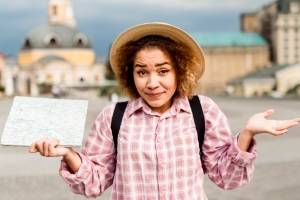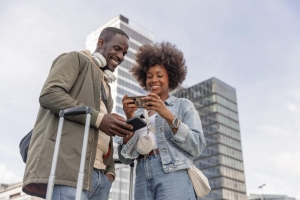Introduction
Kenya is one of Africa’s most popular travel destinations, famous for its stunning landscapes, diverse wildlife, vibrant culture, and warm hospitality. Whether you’re coming for a thrilling safari, a beach escape on the Swahili coast, or a city adventure in Nairobi, Kenya has something for every traveler.
This guide will help first-time visitors, adventure travelers, and luxury tourists understand what to expect when visiting Kenya, from arrival procedures to accommodation, transportation, food, and safety.
Arrival & First Impressions
Immigration & Customs at Major Entry Points
- Kenya’s main international airports are Jomo Kenyatta International Airport (NBO) in Nairobi and Moi International Airport (MBA) in Mombasa. Other entry points include Kisumu International Airport (KIS) and land borders with Uganda and Tanzania.
- E-visas are required for most travelers and should be applied for online before arrival.
- Upon arrival, expect customs checks for restricted goods, and have your yellow fever vaccination certificate ready if traveling from a risk zone.
Language
- English and Swahili are the official languages. English is widely spoken, but knowing a few Swahili words like “Jambo” (hello), “Asante” (thank you), and “Karibu” (welcome) can help.
- Many local dialects exist, depending on the region you visit.
Accommodation Options
Budget Options
- Hostels and backpacker lodges are common in major cities and towns, offering affordable stays for budget travelers.
- Basic guesthouses are available in rural areas.
Mid-Range Hotels and Lodges
- Business hotels, boutique lodges, and mid-range safari camps provide comfort at reasonable prices.
- Popular areas like Nairobi, Naivasha, and Diani Beach offer a variety of options.
Luxury Safari Lodges & Private Game Reserves
- Kenya is home to some of the world’s best safari lodges, especially in Masai Mara, Amboseli, and Laikipia.
- Private game reserves offer exclusive experiences, including hot-air balloon safaris, private game drives, and luxury tented camps.
Transportation & Getting Around
Domestic Flights vs. Road Travel
- Kenya is vast, and domestic flights (via airlines like Safarilink, AirKenya, and Jambojet) are the fastest way to travel between distant locations.
- Road travel is cheaper but time-consuming, with some remote areas requiring 4×4 vehicles.
Car Rental & Self-Drive Options
- Renting a car is possible, but self-driving can be challenging due to rough roads, aggressive drivers, and unpredictable traffic.
- Hiring a driver or guide is recommended for long-distance travel or safaris.
Public Transport (Buses, Matatus, and Taxis)
- Matatus (shared minibuses) are the most common public transport but can be crowded and chaotic.
- Long-distance buses operate between cities, but safety varies by company.
- Ride-hailing services like Uber and Bolt are available in Nairobi and Mombasa.
Food & Dining
Traditional Kenyan Cuisine
- Ugali (maize flour porridge) is a staple, often served with Nyama Choma (grilled meat), fish, or vegetables.
- Sukuma Wiki (collard greens), Chapati (flatbread), and Githeri (maize and beans stew) are common dishes.
- The coastal region offers Swahili cuisine, including Biriyani and Pilau flavored with rich spices.
Restaurants & Street Food Culture
- Nairobi and Mombasa have excellent restaurants serving local and international cuisine.
- Street food stalls sell delicious and affordable snacks like Samosas, Mahamri (sweet fried dough), and Mutura (grilled sausage).
Availability of International Cuisine
- Major cities offer Indian, Chinese, Italian, Middle Eastern, and fast food options.
- Vegetarian and vegan meals are available, but not as common in rural areas.
Money & Costs
Daily Budget Expectations
- Budget travelers: $30–$60 per day
- Mid-range travelers: $80–$200 per day
- Luxury travelers: $300+ per day
Common Costs
- Accommodation: Budget stays ($10–$40), mid-range hotels ($50–$150), luxury lodges ($300+).
- Meals: Local restaurants ($2–$10), mid-range dining ($15–$30), fine dining ($50+).
- Transportation: Matatus ($1–$5), taxis ($5–$20), domestic flights ($100+).
- Activities: Safari park entry ($40–$80), guided tours ($50+), beach excursions ($20–$100).
Payment Methods
- Kenyan Shilling (KES) is the official currency.
- Mobile money (M-Pesa) is widely used for payments, even in small shops.
- Credit cards are accepted in hotels, malls, and restaurants but not always in rural areas.
Safety & Travel Tips
Common Travel Concerns
- Health precautions: Malaria is present in some areas, so taking anti-malaria medication and using insect repellent is advised.
- Emergency contacts: Dial 999 for emergencies.
- Common scams: Beware of overcharging taxis, fake tour operators, and pickpockets in crowded areas.
Best Practices for Tourists
- Avoid walking alone at night, especially in Nairobi’s downtown and informal settlements.
- Always use licensed taxis or ride-hailing apps for transport.
- Dress modestly in religious or rural areas.
Conclusion
Kenya is a thrilling and diverse destination, offering everything from world-famous safaris to vibrant cities and breathtaking beaches. Understanding what to expect—from arrival and accommodation to food, money, and safety—will help you have a smooth and enjoyable trip.
Whether you’re a first-time visitor, adventure seeker, or luxury traveler, Kenya promises unforgettable experiences that will leave you wanting more.
Karibu Kenya! (Welcome to Kenya!)







